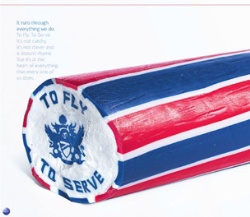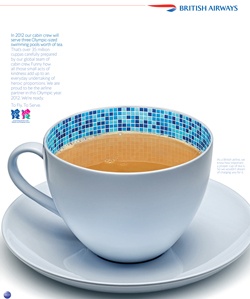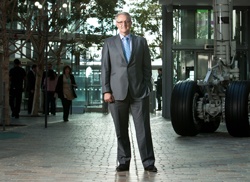Flying the brand flag for British Airways
Frank van der Post has been credited with turning around British Airways’ fortunes since he joined the national flag carrier as managing director of brands and customer experience in 2011. He talks to Jonathan Bacon about the brand’s ongoing strategy.
British Airways has had a bumpy few years. In 2010, it posted its biggest ever loss of more than £500m as the recession, a fall in passenger numbers and the effect of strike action by cabin crew took its toll. Just last year, it was languishing towards the bottom of the YouGov BrandIndex table for brand buzz, which measures public sentiment towards organisations. But with the arrival of top marketer Frank van der Post at the start of 2011, its fortunes have begun to turn around.
Since he joined as managing director of brands and customer experience, the airline has risen in the affections of the travelling public and by last month had reached second place among all airlines in the BrandIndex buzz ratings. On the back of showpiece marketing campaigns and a major investment programme, Van der Post has helped steady the brand’s reputation in a notoriously turbulent industry, helping it to move on from the industrial unrest and economic pain that has dogged the business in recent years. BA is now confident enough once more to take on the likes of easyJet and Ryanair with its latest campaign that glories in the premium service it offers on short-haul routes.
Van der Post, an amiable Dutchman with more than 25 years’ experience in hospitality, says he cannot take all the credit for the upswing in the airline’s fortunes. “BA has always had a fantastic reputation as a brand - it’s been an innovator in the aviation industry and in leading the way in service for decades,” he claims. “But in any business, you get to a point where you do things because that’s the way you’ve done them for the past five years. Somebody new coming in questions that thinking and you get a new drive for innovation, which I think is one of the things we’ve seen in the past 18 months.”
Marketing Week meets Van der Post at BA’s huge, atrium-like headquarters next to Heathrow Terminal 5, which projects an image of zen calm. Although that could in part be down to the idyllic village set-up in the heart of the building, where trees and shops line the lobby, it also seems that the nation’s flag-bearing carrier is more settled and stable than it has been for a long time.
‘To Fly. To Serve’
The rise in positive sentiment around the brand is vindication for BA’s decision last autumn to undertake its first major integrated brand campaign for 10 years, using the line ‘To Fly. To Serve’, from its coat of arms. BA described the campaign, developed with agency BBH, as “a stake in the ground” that would give the brand a new sense of purpose.

The centrepiece of the relaunch was a nostalgic celebration, a 90-second TV spot that paid tribute to the early aviators and the pilots who followed them, right up to the modern day. To coincide with the brand relaunch, BA also announced a five-year plan to invest £5bn on the ‘customer experience’, including new aircraft and improved catering and services.
Van der Post, who joined BA from hotel group Jumeirah, began overseeing the brand relaunch from day one. He says the campaign has helped to clarify BA’s core values to both the public and its 40,000 employees. “We quickly recognised that we had something here that we didn’t have to invent or make up,” he says.
“To Fly. To Serve isn’t just another advertising slogan - it’s been part of us for decades and it sits right in our DNA. The strength of it is that it not only allows us to articulate who we are to the outside community, but it gives us a very strong rallying cry for the internal community too.”
Although the TV spot was a celebration of BA’s 92-year history and heritage, Van der Post was keen to move the campaign on relatively quickly. “The advert did extremely well on research both externally and internally,” he says. “So that demonstrated it was the right advert at the right time at the start of this journey. But we also knew that you can’t keep harping on about what you’ve been doing over the past 90 or so years - you need to start looking at what you are today and how you reach a different audience.”
The 2012 Olympics offered Van der Post the opportunity to maintain BA’s momentum from the To Fly. To Serve launch and reach out to a new demographic. As a Tier One sponsor, the airline threw itself into the occasion, developing an eye-catching campaign (see Olympics case study here[1]). Its activations included a special ‘Firefly’ plane that brought the Olympic flame onto UK soil and the Park Live event, in which it set up an area of giant screens and picnic tables within the Olympic Park.
Taking risks
BA also showed an edgier, riskier side to itself when it ran a ‘Don’t Fly’ campaign that urged Brits to stay in the country and “support the home team”. Van der Post says this was a calculated gamble that paid off. “The conundrum,” he says, “was how do we as an airline that typically flies people out of the country support the home team and the Olympics as a Tier One sponsor?
“When we started to kick around the idea of doing a Don’t Fly campaign, we looked at other campaigns that had told people not to use their products - Yorkie bars, for example, and the ‘Not for girls’ slogan worked well.”
Van der Post jokes that selling the campaign idea to the airline’s leadership team was “an interesting exercise”, though he adds that it ultimately received broad support. “The whole ‘home games advantage’ idea tapped into the emotions of the nation and has been a phenomenal success,” he claims.
The irreverent attitude behind the Don’t Fly campaign suggests BA, which has taken itself rather seriously in the past, is softening its image somewhat. Indeed, in the run-up to the games, BA also ran a tongue-in-cheek ‘bag race’ advert that portrayed the airline’s baggage handling service as a race between different pieces of luggage.

Van der Post explains that while the Olympics enabled BA to experiment with campaigns, the brand as a whole is also “loosening up” in a bid to win new customers. He points out that his status as a Dutchman and coming into BA from a different industry has helped to provide the fresh perspective the airline was looking for when it hired him.
“I think we needed to become a bit more contemporary,” he says. “If you look at our new B777-300ER aircraft, it is a very contemporary plane - absolutely gorgeous. That is where BA is going and we just need to get the brand message there as well.
“So as a brand we needed to become a little bit more relaxed about ourselves. We want the brand to be relevant to a broader audience and that means you have to be relevant in your product offering and in your communications to a wider group of people.”
In order to appeal to this broader audience, BA must re-assert itself in the short-haul market. While the brand has become synonymous with executive lounges and long-haul, first-class travel, the carrier has lost ground to low-cost rivals that offer no-frills flights to European holiday destinations.
The acquisition of bmi in April proved the airline’s intention to claim back share in the short-haul market. Last month, BA also launched a new campaign designed to compare its all-inclusive service with what it claims are the hidden charges of low-cost carriers.
“I think it’s important you have a diversified segmentation of customers,” explains Van der Post. “Business travellers are obviously crucially important to us and that isn’t going to change. But that doesn’t mean that you should pay less attention to all the other parts of the puzzle. We feel that short-haul is an opportunity to reclaim some of the territory there and reposition ourselves from a premium perspective.”
While first-class passengers are likely to be more demanding on customer service, economy class flying is an increasingly commoditised market in which most people opt for the cheapest means of getting from A to B. However, Van der Post is convinced it is possible to win over customers in the short-haul market by educating them on service and price differences between carriers (see Marketer2Marketer, here[2]).
To ensure BA maintains its premium position on customer service, much of Van der Post’s work over the past two years has focused on staff engagement. In the run-up to launching the To Fly. To Serve campaign, for example, the company looked inwards and sought employee feedback as part of a huge fact-finding effort.
“During my first six months, we drove an improvement programme across the business to really demonstrate that we wanted to deliver on the To Fly. To Serve promise,” says Van der Post. “Then we started a big engagement campaign that said to staff ‘join the conversation and share your stories about the business with us’. We got a great conversation going through the company that built towards To Fly. To Serve.”
This level of engagement is crucial in the context of BA’s troubled past with industrial action. BA launched the ‘aviators’ advert internally a day before it went public by setting up a dozen preview cinema screens across the airline’s Terminal 5 bases. “We basically said to the staff that we don’t want this to end up on any blog or website but we want you to see it first,” explains Van der Post. “That sent a really important message to our colleagues that we trust them and that we’re all part of this conversation.”
Securing BA’s future
While BA has seen a bounce from its relaunch campaign and its work around the Olympics, Van der Post knows there is more work to do to secure the BA brand for the long-term. He points out that one of the biggest differences between the hotel industry and the airline industry is the long project lead times in the latter, which require marketers to plan their strategies many years in advance.

“If you want new planes in 2020, you need to start thinking about it now because it takes you three or four years to place an order and get them delivered,” he says. “So there’s a lot of forward thinking with that and how that ties into route slots, legislation and so on. We’re already looking at what 2020-2025 is going to look like and while that’s nowhere near definition, clearly it will come under what we’re building with the brand at the moment.”
In August, it was announced that BA had made an operating profit of €13m (£8.1m) in the first six months of the year - the only good news for parent company IAG, which announced losses of €390m due largely to the struggles of its other carrier Iberia. After helping to get BA back on the right track, Van der Post is determined not to let the brand’s reputation slide, particularly while trading conditions remain challenging.
“To me a brand is immensely valuable and you need to maintain that value,” he says. “It’s like driving a premium car - if you let it rot away, it eventually becomes worthless, but if you look after it, it will be worth more. The airline industry is very competitive and it’s difficult to make margins, so you need to invest wisely in the brand.”
CV
January 2011 to date Managing director, brands and customer experience, British Airways
2008-2011 Chief operating officer, Jumeirah Group
2005-2008 Senior vice-president for the Americas, Jumeirah Group
1985-2005 Various roles at InterContinental Hotels Group, rising to vice-president for the east coast of the United States and the Caribbean and general manager of The Barclay in New York
1984 Master of science in hotel administration from Florida International University
References
- ^ see Olympics case study here (www.marketingweek.co.uk)
- ^ see Marketer2Marketer, here (www.marketingweek.co.uk)









